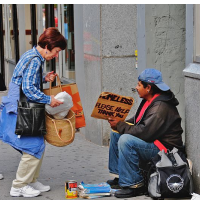20 Million Americans Live on Less than $3,000 a Year
 Helping a Homeless Man in New York City (photo: Ed Yourdon)
Helping a Homeless Man in New York City (photo: Ed Yourdon)
Even as economists tout macro-economic data showing the economy picking up steam, the benefits are still not trickling down to the middle class, much less to the poor, according to data released last week by the Census Bureau. From 2000 to 2012, poverty increased overall by 3.7%, and by 5.6% among children, even as median income for non-elderly households fell from $64,843 to $57,353, a decline of $7,490, or 11.6%.
For the eleventh time in twelve years, poverty has worsened or gotten no better in the United States. The official poverty rate remains at 15%, meaning that 46.5 million Americans are living on less than $18,300 for a family of three, including 21.8% of all children (16.1 million kids), 27.2% of African-Americans, 25.6% of Hispanics and more than 28% of people with disabilities.
In 2012, more than one-third (34.6%) of all people living in poverty were children, including 37.9% of black children and 33.8% of Hispanic children. The poverty rate for families with children headed by single mothers was 40.9%, and of the 7.1 million families with children living in poverty, 4.1 million (57.7%) are headed by a single mother.
But nearly half of the poor—43.9% or 20.4 million Americans—live below one-half of the poverty line, or $9,150 for a family of three. Thus 6.6% of the total population lives in “deep poverty,” including 9.7% of children.
Poverty, regardless of its depth, along with the daily stresses that accompany it, is especially harmful to children, especially young ones. Studies have shown that living in poverty impairs the cognitive development of children, leading to poorer academic performance, reduced income potential and shorter lives.
Also remaining stagnant last year at 106 million Americans was the number of those living in “near poverty,” below twice the poverty line—less than $36,600 for a family of three. This means that more than one in three Americans are either already poor or are living one catastrophe—a job loss or serious illness—away from poverty.
Finally, the data show that the so-called “social safety net” has helped keep the situation from getting even worse. In 2012, unemployment insurance kept 1.7 million workers out of poverty; Social Security did the same for 15.3 million elderly Americans, and food stamps 4 million.
-Matt Bewig
To Learn More:
Already More Than a Lost Decade: Income and Poverty Trends Continue to Paint a Bleak Picture (by Elise Gould, Lawrence Mishel, and Heidi Shierholz, Economic Policy Institute)
This Week in Poverty: New Data, Same Story (and Same Dangerous House Republicans) (by Greg Kaufmann, The Nation)
2013 Poverty Thresholds and Guidelines (Department of Health and Human Services)
Extreme Poverty Neighborhoods Make a Comeback in U.S. (by Noel Brinkerhoff, AllGov)
- Top Stories
- Unusual News
- Where is the Money Going?
- Controversies
- U.S. and the World
- Appointments and Resignations
- Latest News
- Trump to Stop Deportations If…
- Trump Denounces World Series
- What If China Invaded the United States?
- Donald Trump Has a Mental Health Problem and It Has a Name
- Trump Goes on Renaming Frenzy






Comments